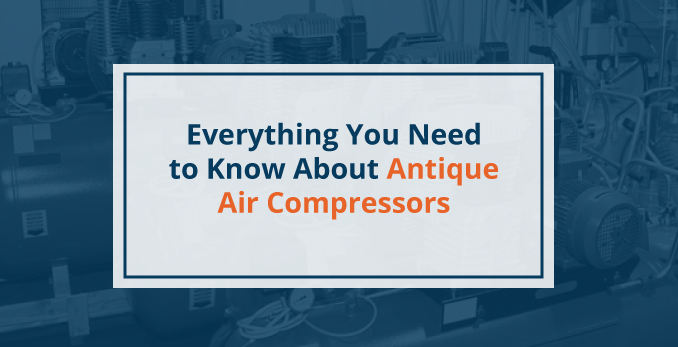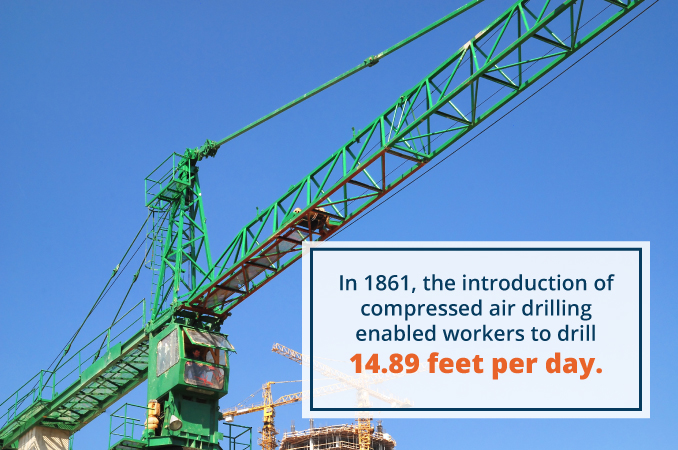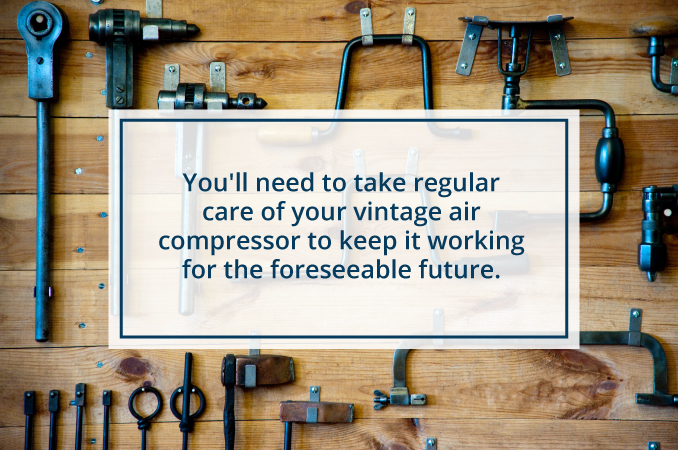
The contemporary air compressor is utilized across various industries for numerous applications. From the construction of furniture, appliances, automobiles and buildings to the manufacturing of canned goods and cleaning products, air compression plays a crucial part in the production of a vast majority of things that people see and consume on a daily basis.
Given the preeminence of air compression in modern manufacturing, it’s hard to imagine a time when such machinery didn’t exist. The compression technology that drives most of today’s industries is a fairly recent innovation. Prior eras had to make do with far more primitive means of air compression.
A Brief History of Air Compressors
In some form or another, the concept of air for power extends back several thousand years. The first air compressor known to man was the human lung. Back in the days when heat was produced by rubbing sticks together, the power of human breath is what villagers relied upon to stoke fire.
The practice of man-made air pressure prevailed until around the start of the third millennium B.C., when the production and purification of metals became commonplace. In order to melt materials like copper and gold into shape, the people involved in metallurgy needed much higher temperatures, for which lungs were insufficient. After all, lungs aren’t machinery. Even the most healthy, strong and robust human lungs are only capable of wielding up to .08 bar of air pressure. Considering that one bar equals merely 14.5 psi, something much more powerful was necessary.
Halfway through the second millennium B.C., a newly developed air compressor known as the bellows came into use. The tool was essentially a bag that was operable via hands and later feet. With bellows, it was possible to generate air concentrations that were powerful enough to build fires at much higher temperatures than before.
More than two thousand years would pass before the next revolution in air compression was ushered in by the vacuum pump in 1650. Invented by German physicist Otto Von Guericke, the vacuum pump was designed to show the potential of air pressure. The device itself could suck gas from tight compartments and leave spaces free of air.
The next breakthrough was delivered by 18th century English engineer John Smeaton, who superseded the pump with a blowing cylinder that ran on a water wheel. However, Seamton’s 1762 invention would only enjoy brief popularity before it too was replaced by an even more influential design launched in 1776 by English industrialist John Wilkinson. His blasting machine would serve as the model for the future of air compression machinery.
By the late 1700s, the usage of air compression had expanded from factory-based metalwork into the field of mining, where it was used to produce ventilation in deep, dark tunnels. One of Europe’s most ambitious undertakings to be driven largely with compressed air was the drilling of the Mont Cenis Tunnel, which would carry the Turin–Modane railway through the Swiss Alps. Construction started in 1857 and would ultimately take 14 years to complete and extend across eight miles. The construction was only moving at nine inches per day until 1861, when the introduction of compressed air drilling enabled workers to drill 14.89 feet per day.
As the 19th century dawned, the benefits of compressed air were being harnessed for newer innovations, such as the transmission of energy. A high-water mark of such innovation was the 1888 unveiling of the world’s first compressor plant — courtesy of Austrian developer Viktor Popp — which wielded 18,000 kW within three years.
With compression technology expanding globally, a number of pneumatic tools hit the market. Inventor Simon Ingersoll seized upon the ability of compressors to turn air into power by introducing the pneumatic rock drill in 1871. Through his namesake company, further pneumatic tools were developed that would aid in the carving of Mount Rushmore during the late 1920s, as well as the building of the world’s first atomic submarine during the early 1950s.
According to some historians, the modern age of air compression began in the early 1940s, when it was realized that compressed air could enable divers to embark on deep-sea explorations for prolonged lengths of time. During the 1960s, the technology paved the way for self-service, drive-through car washes.
Contact Us Learn More Find a Dealer Near You
Vintage Air Compressors from the 1910s to the 1950s
“2 Valuable Machines in 1” was the tagline for the U.S. De Luxe Two Stage Combined Compressor and Buffer, or Grinder Head: a product touted for its “all round efficiency.” The United States Air Compressor Co. noted its time, money and space-saving benefits. The company combined its popular De Luxe Air Compressor with a buffer or grinder head in one single-motor-operated design, as advertized in a 1918 installment of the Automobile Trade Journal.
Superlatives used to describe the Model G-16 Quincy Silent Air Master in a classic, full-page ad included:
- Quick pumping
- Long life
- No vibration
- Silent
- Economical
The tagline boasted “More Air Service Per Dollar” from Quincy Compressor Co. in the Nov. 12, 1925, issue of Motor Age. Wall Pump & Compressor Co. ran an earlier ad — dated Dec. 20, 1923 — in the same publication for the G-16, which touted 12 facts about the Silent Air Master, including its aluminum intercooler, finned aftercooler, fan-blade flywheel, lubricating splash system, and crankcase-bolted cylinders.
In the late 1920s, Champion Pneumatic Machinery Co. offered a line of single and two-stage compressors, including:
- The 80-gal. SE-27 and SE-28 models
- The 32-gal. R-70 and N-13 models
- The 60-gal. OE-41, an automatic, ball bearing, 200 lbs. unit that was recommended for tire inflation, air lifts, gas pumps, air tools, and more in a full-page ad that was ran by the Chicago-based company in 1928.
One of the most novel air compressors of the 1920s was the Michelin Man Cast-Iron Air Compressor, which featured a figure of the company’s mascot straddling a miniature, horizontal tank and blowing into a tiny hose. While too small for most tasks that one would consider demanding, the Michelin Man compressor could be used to blow balloons full of air, and it has long been one of the more collectible antique air compressors from the early 20th century.
Quincy Compressor Co. advertised its V-belts in a 1930 ad that ran in National Petroleum News for the company’s horizontal Model F-1 and G-19 units, and vertical Model A and B units. As the first manufacturer to offer V-belts, Quincy touted the unique benefits of the feature, which allowed users to generate compressed air without any bearing tension, slippage, or power-eating idler.
By the late 1930s, there were 28 different models to choose from in the Quincy line of air compressors. The company’s own product brochure from this era lists the following types and models:
- Two-stage horizontal models, ranging in size from 3.7 to 20 cubic feet
- Two-stage horizontal models (pressure lubricated), ranging in size from 21 to 40 cubic feet
- Single-stage horizontal models, single-cylinder and duplex cylinder, ranging in size from 2.8 to 26.2 cubic feet
- Single-stage horizontal models (pressure lubricated), ranging in size from 32 to 45 cubic feet
- Standard vertical tank models, single and two-stage, ranging in size from 3.7 to 17.2 cubic feet
- Model VA-4, size 2.5 x 2.5 single cylinder, vertical tank
- Model FA-4, size 2.5 x 2.5 single cylinder
- Model FX-2, size 2 x 1.3/4 single cylinder
- Model FX-8, size 2.3/8 x 2 duplex cylinder
Quincy guaranteed a host of unique features with this new line of models, including copper-finned aftercooler, rubber mounting, two-tone finish, drop forged crankshaft, Timken bearings, semi-steel pistons, Lynite rods, constant level oiling and cushioned steel valves for quieter operation.
In a March 1950 ad that appeared in Implement & Tractor Magazine, Quincy promoted a larger compressor that was designed to be mounted on a Jeep. The Quincy Model 216-S Compressor could simply be placed in the back seat of a Jeep and used portably wherever one might have needed to produce compressed air. As stated in the ad, the 216-S was convenient for spraying bridges, lubricating equipment, blowing off machinery, tree pruning, cemetery work, and spray painting barns, houses and fences.
How to Identify an Antique Air Compressor
Air compressors are used by craftsmen for everything from spray painting and sanding to operating staplers and nail guns. One of the greatest advantages of the technology is that air compressors support various types of tools, which are ultimately spared the strain of running off separate motors. When it comes to older air compressors, the appeal could center on the rarity of a vintage machine, or perhaps the novelty in having an outdated piece of machinery that is still operable. Determining whether or not an air compressor is vintage can easily be done with the following steps:
- Look along the sides of a compressor for a patent number, which is often listed near the name of the manufacturer on older machines.
- Go to Google Patents to run a search on the patent number. You might find basic information on the model, such as the patent filing and issue date, as well as the manufacturer and an early design drawing of a compressor.
- Upload images of the air compressor to a tool forum on the web, the kind where mechanics and vintage tool connoisseurs are likely to recognize the model. Include pictures taken from all sides of the unit.
- Check the backside of the tank to see if there’s a stamp that lists the year that the compressor was produced, along with the name of the manufacturer. If the stamp only lists the manufacturer, do a Google search of the name to find the dates the company started and stopped production.
Maintenance Tips for Vintage Air Compressors
If you’ve purchased a vintage air compressor that is still in operable condition and intend to use it to power pneumatic tools for projects, there are maintenance steps that you should consider. You’ll need to take regular care of your machine to keep it working for the foreseeable future.
Drain the tank of condensation – The natural air that gets sucked into the inlet for use in an air compressor will always contain some amount of moisture. The colder the climate, the likelier it is that moisture will collect along the interior walls of the compressor tank. Most tanks, old and new, are equipped with drain valves that are designed for the release of moisture on a regular basis. Don’t neglect this step because water buildup within a tank can lead to rust along the insides.
Keep the air filters clean – Moisture isn’t the only problem with natural air. There’s also plenty of aerosolized dirt in the air that goes into a compressor. The intrusion of dirt can gradually take a toll on the quality and performance of your tools. Therefore, it’s crucial to clean your air filter regularly, especially if you’re working in an area where dirt and dust are constantly being kicked up into the air.
Tighten the screws – Due to the constant vibrations of a running air compressor, fasteners are likely to come loose from time to time. This is especially common with antique air compressor parts. For that reason, it’s important to check the screws, nuts and bolts on a monthly basis and tighten anything that might have come slightly undone.
Inspect hoses periodically – If the tank is the lungs of an air compressor, the hoses are the blood vessels. Therefore, you never want the hoses to get ruptured or clogged because that could cause them to crack and leak, which could ultimately put further stress on related components. In order to prevent such damage from occurring, check the hoses regularly for signs of wear, and replace any that appear corroded. It’s probable that an antique air compressor has hoses that need replacing, especially if you plan to make use of the machine going forward.
Monitor and change the oil – An old machine simply cannot function without a new supply of oil every three months or so. If your vintage air compressor uses oil, check it regularly to make sure that the supply is optimal. After every 300 hours of use, replace the oil with a fresh dose. This will help ensure that the air compressor runs smoothly, despite the many decades that have passed since it was manufactured.
Ensure the safety valve is working – New and antique air compressors alike are all equipped with in-built safety pressure valves. In the event that the PSI soars to a dangerous extreme, the valve opens. In order to prevent accidents from occurring with the air receiver, the valve should be tested for maximum reliability.
Clean the engine’s fuel tank – When you find a vintage air compressor that’s still operable despite decades of prior use, chances are it’s partly because the prior owners cleaned the fuel tank on a periodic basis. About every 12 months, it’s a good idea to cleanse the compressor engine to prevent the buildup of grimy fuel deposits. By doing so, you’ll increase the likelihood that the machine will remain usable for a few more generations.
Wash the intercooler parts – One of the secrets to a vintage air compressor that lasts throughout the ages is a clean set of intercooler parts, because these are what keep the machine’s temperatures down as it operates. Preventing grime from depositing on the tubes and fins of the intercooler is an integral part of air compressor maintenance. Keeping them clean is a cinch — simply blow the parts with the air hose from time to time either before or after a day’s operations.
New vs. Old Air Compressors
Collecting old air compressors can be a fun hobby, whether you buy them for their historical and aesthetic appeal, or to actually power them up — providing you find antique air compressors that are still operable. As unique and novel as vintage air compressors can be, you might want a machine that’s specifically built to handle the challenges of today’s demanding tasks, from spray painting and nailing to cleaning and tire refills.
Since the days of old air compressors from a century ago, Quincy has been at the forefront of making compressed air technology accessible to mechanics and craftsmen of all trades throughout North America and beyond. From the Model G-16 Silent Air Master unit of the 1920s to the QR-25 1-25 hp Heavy Duty Compressors of today, Quincy has continually updated its line of inventory to make things easier for workers and hobbyists alike.
Anytime operations are underway and compressed air is a necessity, Quincy has treated customers to unique offers on air compressor products, parts and services. Our customers have access to round-the-clock customer support, seven days a week, through authorized Quincy partners.
If you’re looking to buy a new compressor with the power and longevity to still function optimally once it becomes an antique, look no further than Quincy. In order to find out more about Quincy air compressors, visit our website where you can contact our service reps or download our white pages.





